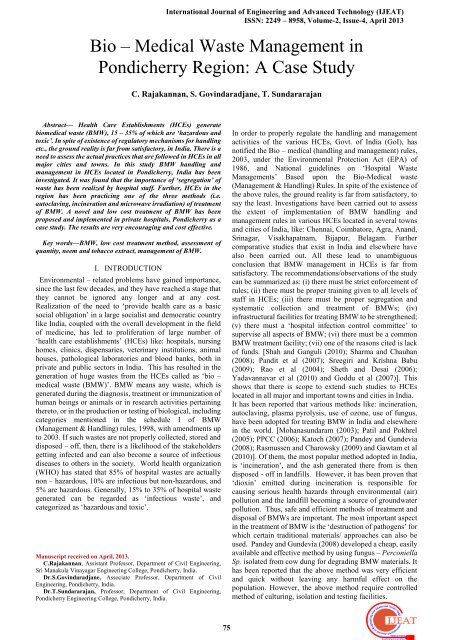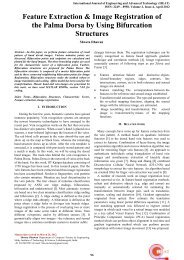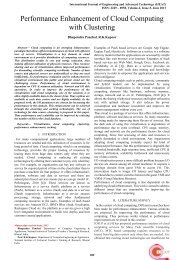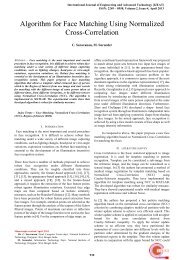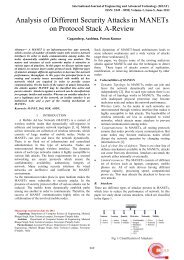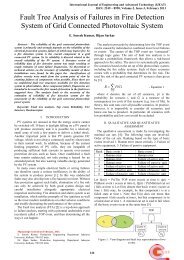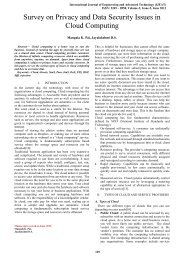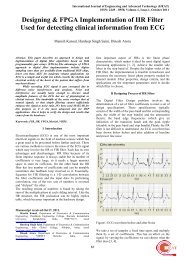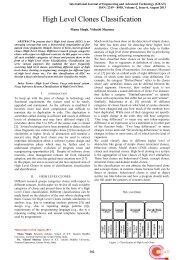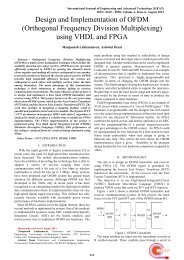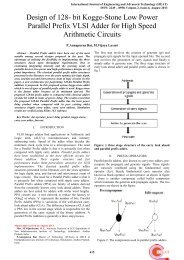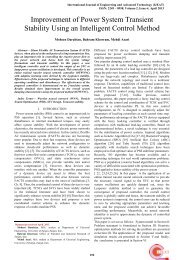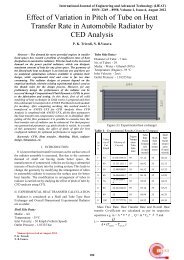Medical Waste Management in Pondicherry Region - International ...
Medical Waste Management in Pondicherry Region - International ...
Medical Waste Management in Pondicherry Region - International ...
You also want an ePaper? Increase the reach of your titles
YUMPU automatically turns print PDFs into web optimized ePapers that Google loves.
<strong>International</strong> Journal of Eng<strong>in</strong>eer<strong>in</strong>g and Advanced Technology (IJEAT)ISSN: 2249 – 8958, Volume-2, Issue-4, April 2013Bio – <strong>Medical</strong> <strong>Waste</strong> <strong>Management</strong> <strong>in</strong><strong>Pondicherry</strong> <strong>Region</strong>: A Case StudyC. Rajakannan, S. Gov<strong>in</strong>daradjane, T. SundararajanAbstract— Health Care Establishments (HCEs) generatebiomedical waste (BMW), 15 – 35% of which are ‘hazardous andtoxic’. In spite of existence of regulatory mechanisms for handl<strong>in</strong>getc., the ground reality is far from satisfactory, <strong>in</strong> India. There is aneed to assess the actual practices that are followed <strong>in</strong> HCEs <strong>in</strong> allmajor cities and towns. In this study BMW handl<strong>in</strong>g andmanagement <strong>in</strong> HCEs located <strong>in</strong> <strong>Pondicherry</strong>, India has been<strong>in</strong>vestigated. It was found that the importance of ‘segregation’ ofwaste has been realized by hospital staff. Further, HCEs <strong>in</strong> theregion has been practic<strong>in</strong>g one of the three methods (i.e.autoclav<strong>in</strong>g, <strong>in</strong>c<strong>in</strong>eration and microwave irradiation) of treatmentof BMW. A novel and low cost treatment of BMW has beenproposed and implemented <strong>in</strong> private hospitals, <strong>Pondicherry</strong> as acase study. The results are very encourag<strong>in</strong>g and cost effective.Key words—BMW, low cost treatment method, assessment ofquantity, neem and tobacco extract, management of BMW.I. INTRODUCTIONEnvironmental – related problems have ga<strong>in</strong>ed importance,s<strong>in</strong>ce the last few decades, and they have reached a stage thatthey cannot be ignored any longer and at any cost.Realization of the need to ‘provide health care as a basicsocial obligation’ <strong>in</strong> a large socialist and democratic countrylike India, coupled with the overall development <strong>in</strong> the fieldof medic<strong>in</strong>e, has led to proliferation of large number of‘health care establishments’ (HCEs) like: hospitals, nurs<strong>in</strong>ghomes, cl<strong>in</strong>ics, dispensaries, veter<strong>in</strong>ary <strong>in</strong>stitutions, animalhouses, pathological laboratories and blood banks, both <strong>in</strong>private and public sectors <strong>in</strong> India. This has resulted <strong>in</strong> thegeneration of huge wastes from the HCEs called as ‘bio –medical waste (BMW)’. BMW means any waste, which isgenerated dur<strong>in</strong>g the diagnosis, treatment or immunization ofhuman be<strong>in</strong>gs or animals or <strong>in</strong> research activities perta<strong>in</strong><strong>in</strong>gthereto, or <strong>in</strong> the production or test<strong>in</strong>g of biological, <strong>in</strong>clud<strong>in</strong>gcategories mentioned <strong>in</strong> the schedule I of BMW(<strong>Management</strong> & Handl<strong>in</strong>g) rules, 1998, with amendments upto 2003. If such wastes are not properly collected, stored anddisposed – off, then, there is a likelihood of the stakeholdersgett<strong>in</strong>g <strong>in</strong>fected and can also become a source of <strong>in</strong>fectiousdiseases to others <strong>in</strong> the society. World health organization(WHO) has stated that 85% of hospital wastes are actuallynon – hazardous, 10% are <strong>in</strong>fectious but non-hazardous, and5% are hazardous. Generally, 15% to 35% of hospital wastegenerated can be regarded as ‘<strong>in</strong>fectious waste’, andcategorized as ‘hazardous and toxic’.Manuscript received on April, 2013.C.Rajakannan, Assistant Professor, Department of Civil Eng<strong>in</strong>eer<strong>in</strong>g,Sri Manakula V<strong>in</strong>ayagar Eng<strong>in</strong>eer<strong>in</strong>g College, <strong>Pondicherry</strong>, India.Dr.S.Gov<strong>in</strong>daradjane, Associate Professor, Department of CivilEng<strong>in</strong>eer<strong>in</strong>g, <strong>Pondicherry</strong>, India.Dr.T.Sundararajan, Professor, Department of Civil Eng<strong>in</strong>eer<strong>in</strong>g,<strong>Pondicherry</strong> Eng<strong>in</strong>eer<strong>in</strong>g College, <strong>Pondicherry</strong>, India.In order to properly regulate the handl<strong>in</strong>g and managementactivities of the various HCEs, Govt. of India (GoI), hasnotified the Bio – medical (handl<strong>in</strong>g and management) rules,2003, under the Environmental Protection Act (EPA) of1986, and National guidel<strong>in</strong>es on ‘Hospital <strong>Waste</strong><strong>Management</strong>s’ Based upon the Bio-<strong>Medical</strong> waste(<strong>Management</strong> & Handl<strong>in</strong>g) Rules. In spite of the existence ofthe above rules, the ground reality is far from satisfactory, tosay the least. Investigations have been carried out to assessthe extent of implementation of BMW handl<strong>in</strong>g andmanagement rules <strong>in</strong> various HCEs located <strong>in</strong> several townsand cities of India, like: Chennai, Coimbatore, Agra, Anand,Sr<strong>in</strong>agar, Visakhapatnam, Bijapur, Belagam. Furthercomparative studies that exist <strong>in</strong> India and elsewhere havealso been carried out. All these lead to unambiguousconclusion that BMW management <strong>in</strong> HCEs is far fromsatisfactory. The recommendations/observations of the studycan be summarized as: (i) there must be strict enforcement ofrules; (ii) there must be proper tra<strong>in</strong><strong>in</strong>g given to all levels ofstaff <strong>in</strong> HCEs; (iii) there must be proper segregation andsystematic collection and treatment of BMWs; (iv)<strong>in</strong>frastructural facilities for treat<strong>in</strong>g BMW to be strengthened;(v) there must a ‘hospital <strong>in</strong>fection control committee’ tosupervise all aspects of BMW; (vi) there must be a commonBMW treatment facility; (vii) one of the reasons cited is lackof funds. [Shah and Ganguli (2010); Sharma and Chauhan(2008); Pandit et al (2007); Sreegiri and Krishna Babu(2009); Rao et al (2004); Sheth and Desai (2006);Yadavannavar et al (2010) and Goddu et al (2007)]. Thisshows that there is scope to extend such studies to HCEslocated <strong>in</strong> all major and important towns and cities <strong>in</strong> India.It has been reported that various methods like: <strong>in</strong>c<strong>in</strong>eration,autoclav<strong>in</strong>g, plasma pyrolysis, use of ozone, use of fungus,have been adopted for treat<strong>in</strong>g BMW <strong>in</strong> India and elsewhere<strong>in</strong> the world. [Mohanasundaram (2003); Patil and Pokhrel(2005); PPCC (2006); Katoch (2007); Pandey and Gundevia(2008); Rasmussen and Charowsky (2009) and Gawtam et al(2010)]. Of them, the most popular method adopted <strong>in</strong> India,is ‘<strong>in</strong>c<strong>in</strong>eration’, and the ash generated there from is thendisposed - off <strong>in</strong> landfills. However, it has been proven that‘diox<strong>in</strong>’ emitted dur<strong>in</strong>g <strong>in</strong>c<strong>in</strong>eration is responsible forcaus<strong>in</strong>g serious health hazards through environmental (air)pollution and the landfill becom<strong>in</strong>g a source of groundwaterpollution. Thus, safe and efficient methods of treatment anddisposal of BMWs are important. The most important aspect<strong>in</strong> the treatment of BMW is the ‘destruction of pathogens’ forwhich certa<strong>in</strong> traditional materials/ approaches can also beused. Pandey and Gundevia (2008) developed a cheap, easilyavailable and effective method by us<strong>in</strong>g fungus – PerconiellaSp. isolated from cow dung for degrad<strong>in</strong>g BMW materials. Ithas been reported that the above method was very efficientand quick without leav<strong>in</strong>g any harmful effect on thepopulation. However, the above method require controlledmethod of cultur<strong>in</strong>g, isolation and test<strong>in</strong>g facilities.75
Bio – <strong>Medical</strong> <strong>Waste</strong> <strong>Management</strong> <strong>in</strong> <strong>Pondicherry</strong> <strong>Region</strong>: A Case StudyIn the absence of the above, the adoption of the abovemethod becomes difficult. Jayanthi and Sanoj<strong>in</strong>i (2010) haveused ‘neem’ extract for destruction of pathogens <strong>in</strong> <strong>in</strong>fectionsBMW collected from a hospital at Coimbatore, India, andhave reported that lime solution has effectively destroyed thepathogens with respect to time, where as, reduction <strong>in</strong>percentage is better only <strong>in</strong> fresh neem leaves extract.However, the feasibility and performance of such treatmentmethods have to be established, by expla<strong>in</strong><strong>in</strong>g the use ofsimilar types of materials either alone and <strong>in</strong> comb<strong>in</strong>ation andbased on extensive studies carried out on BMWs generatedfrom HCEs of India.Hence, the focus of the present study is on: (i) to assess thequality of BMW generated <strong>in</strong> the <strong>Pondicherry</strong> region; (ii) toidentify the exist<strong>in</strong>g treatment / disposal systems andmanagement practices be<strong>in</strong>g followed <strong>in</strong> the various HCEsand critically evaluate them and (iii) to evaluate theperformance of us<strong>in</strong>g ‘neem and tobacco extract’ for thetreatment of BMW, obta<strong>in</strong>ed from a large private hospitallocated <strong>in</strong> <strong>Pondicherry</strong>.II. METHODOLOGYA. Details of study areaThe union territory (UT) of <strong>Pondicherry</strong> comprises of fourregions, and <strong>Pondicherry</strong> region located <strong>in</strong> the east coast ofIndia is the largest one and also the capital of U.T. It liesbetween latitudes 11⁰ 56’ and longitude 79⁰ 53’. The generalslope of the region is towards east. The total geographicalarea of <strong>Pondicherry</strong> is 492 sq km. Recently, it has witnessedtremendous growth <strong>in</strong> education, healthcare and tourism. It isalso home to several reputed hospitals under central, state andprivate sectors, which is a unique feature of the above region.In order to evaluate the performance of the chosen methodsof treatment of BMW, a large private hospital, which hasbeen <strong>in</strong> existence for nearly 15 years and hav<strong>in</strong>g 310 bedswith good <strong>in</strong>frastructure facilities was chosen. The abovechosen hospital is referred as to 'the hospital', henceforth <strong>in</strong>this paper.B. Field surveyA survey was conducted to <strong>in</strong>dentify the various HCEslocated <strong>in</strong> <strong>Pondicherry</strong> region and the amount of wastegenerated <strong>in</strong>clud<strong>in</strong>g the number of beds available, <strong>in</strong> both theGovt. and private sectors. Further, the management practiceslike segregation, treatment and disposal methods that arebe<strong>in</strong>g currently followed <strong>in</strong> all the <strong>in</strong>dentified HCEs, werealso collected. The data thus collected was then analysed, todraw critical <strong>in</strong>ferences there from.C. ExperimentalIn order to experimentally <strong>in</strong>vestigate the usefulness andperformance of the chosen methods on the treatment of‘<strong>in</strong>fectious’ wastes, samples (i.e. cotton wastes) werecollected from ‘the hospital’ and stored <strong>in</strong> airtight conta<strong>in</strong>ers.Tobacco obta<strong>in</strong>ed from local sources and neem (Azadirachta<strong>in</strong>dica) leaves extract solutions were used for treat<strong>in</strong>g theabove waste. The above two materials were used to prepare‘neem’ extract solution and a comb<strong>in</strong>ation of ‘neem’ and‘tobacco’ extract solution. For brevity, ‘tobacco’ extractsolution is used <strong>in</strong> this paper to refer to the abovecomb<strong>in</strong>ation. After treatment, various physico-chemical(COD, total solids, volatile solids, electrical conductivity,alkal<strong>in</strong>ity) and biological parameters (microbial colonycount) were determ<strong>in</strong>ed as per standard methods, (APHA,2005) at different stages of destruction of pathogens. Theresults obta<strong>in</strong>ed were critically analysed to evaluate therelative performance of the chosen treatment methods for the‘<strong>in</strong>fections sample’.III. RESULTS AND DISCUSSIONTable 1: Generated BMW <strong>in</strong> the various HCEs of<strong>Pondicherry</strong> <strong>Region</strong>Sl. Name of the hospitals. No. of QuantityNo.beds (kg/day)I. Government hospitals1 General Hospital 698 1081.92 JIPEMER 1112 1723.63 Chest cl<strong>in</strong>ic 80 1244 Mahatma Gandhi Govt. LeprosyHospital138 213.95 ESI hospital 75 116.256 Primary Health Centre (PHCs) 108 103.68(27Nos)7 Govt. Maternity Hospital 330 511.5Total (A) 3875II. Government and private medical colleges1 Govt. <strong>Medical</strong> College 300 4082 Sri manakula v<strong>in</strong>ayagar medical 320 425.2college3 AarupadaiVeedu <strong>Medical</strong> College &Hospital4 <strong>Pondicherry</strong> Institute of <strong>Medical</strong>Sciences (PIMS)5 Mahatma Gandhi <strong>Medical</strong> Collegeand Research Institute6 Mahatma Gandhi Dental College &Hospital7 Sri Lashm<strong>in</strong>arayanan <strong>Medical</strong>College400 544310 421.6300 40830 40.8220 299.28 Venkatewara <strong>Medical</strong> College 280 380.8Total (B) 2928III. Private health care centres1 St. Joseph of Cluny Nurs<strong>in</strong>g Home 200 2722 Nallam Cl<strong>in</strong>ic 75 1023 Sedhu Nurs<strong>in</strong>g Home 65 88.44 New <strong>Medical</strong> Centre 42 57.125 Sri Mahalakshmi Nurs<strong>in</strong>g Home 20 27.56 Sri Krishna Nurs<strong>in</strong>g Home 20 27.57 Asw<strong>in</strong> Maternity Hospital 08 10.888 Rani Hospital 24 32.649 A.G. Padmavati Hospital 120 163.210 Sri Devi Nurs<strong>in</strong>g Home 10 13.611 Jagadesh Eye Cl<strong>in</strong>ic 02 2.7212 Aurob<strong>in</strong>do Ashram Nurs<strong>in</strong>g 30 40.813 Jothi Eye Care Centre 10 13.614 VKN Hospital 17 23.1215 Kamala Nurs<strong>in</strong>g Home 08 10.8816 Madhava hospital 25 3417 Arav<strong>in</strong>d eye hospital 265 360.4Total (C) 1280A. Field survey(i) Total BMW GenerationThe total amount of BMW generated (<strong>in</strong> kg/day) from each ofthe HCEs are given <strong>in</strong> Table 1. HCEs of the region have beencategorized <strong>in</strong>to: (i) Government hospitals, (ii) Governmentand private medical colleges and (iii) private healthcarecenters. Incidentally, the quantity of BMW generated alsoranks <strong>in</strong> that order, the highest by Govt. hospitals and thelowest by private health care centers.76
The total BMW generated has been assessed as 8.1 tons/day.Of the above, 70 - 80% can generally be considered to fallunder 'non - <strong>in</strong>fectious' wastes.(ii) SegregationIt has been observed that there is a positive change <strong>in</strong> theattitude of hospital staff, where by, the importance ofsegregation has been felt and hence, more and more HCEs <strong>in</strong>this region have presently implemented segregation <strong>in</strong>substantial terms, which is expected to result <strong>in</strong> ‘completesegregation’, <strong>in</strong> future. Further, it was observed that the basicsystem followed is the usual 4 – b<strong>in</strong>s comb<strong>in</strong>ation (3 – b<strong>in</strong>sfor <strong>in</strong>fectious wastes and the fourth one for sharps). Thesegregation practices actually followed <strong>in</strong> all the HCEs canbe classified <strong>in</strong>to any one of the four types, namely; (i) wellsegregated; (ii) substantial segregation (with poormonitor<strong>in</strong>g); (iii) poor segregation and (iv) no segregation. Itis found most of the Government hospitals <strong>in</strong> the <strong>Pondicherry</strong>region fall <strong>in</strong> the second category, whereas, the privatehospitals and nurs<strong>in</strong>g homes fall under the third category.(iii) Pre-treatmentMost <strong>in</strong>stitutions that adopt segregat<strong>in</strong>g of BMWs at source,also pre – treat (i.e. dis<strong>in</strong>fect) the BMWs with 1% of sodiumhypochlorite solution, before send<strong>in</strong>g the samples for furthertreatment and disposal. Apart from the above form ofdis<strong>in</strong>fection, use of calcium hypochlorite, bleach<strong>in</strong>g agent /Dettol were also used.(iv) Treatment and disposalThe HCEs surveyed have been practic<strong>in</strong>g autoclav<strong>in</strong>g,<strong>in</strong>c<strong>in</strong>eration, and microwave irradiation.B. Case study(i) SegregationThe amount of BMW generated by ‘the hospital’ is about 397kg/day, which works to about 1.3kg/day/bed. This is slightlylower than the average quantity reported at national level (i.e.<strong>in</strong> India). [Shah and Ganguli, 2010]. It is found that theBMWs were carefully segregated at source itself and that thehospital staff were very much aware of the handl<strong>in</strong>g andsafety procedures. The solid waste from the hospitalconsist<strong>in</strong>g of bandages, l<strong>in</strong>en and other <strong>in</strong>fection materialsconstituted 30 – 40 % of the total waste. In terms of quantity,<strong>in</strong>fectious waste generated is about 159 kg/day.(ii) Present treatment methodsThe hospital has two <strong>in</strong>c<strong>in</strong>erators, one operat<strong>in</strong>g on furnaceoil and the other us<strong>in</strong>g diesel. The capacity of the <strong>in</strong>c<strong>in</strong>eratoris about 500 kg, with an operat<strong>in</strong>g temperature of about900°C. The <strong>in</strong>c<strong>in</strong>erators were found to be operat<strong>in</strong>g between6 to 9 pm and the ‘<strong>in</strong>fectious waste’ generated is generallygets <strong>in</strong>c<strong>in</strong>erated <strong>in</strong> about two hours. Control devices havebeen <strong>in</strong>stalled to prevent air pollution by particulate mattersand flue gases, as a result of <strong>in</strong>c<strong>in</strong>eration.(iii) Treatment of Neem and Tobacco extractsWith<strong>in</strong> 3 hours of treatment by both the methods (i.e. us<strong>in</strong>gneem and tobacco extract), the bacterial colony count (BCC)has decreased by one order of magnitude and it cont<strong>in</strong>uous todecrease. At the end of 9 hours of treatment the BCC is only1% of the raw BCC. In other words there is a reduction ofthree orders of magnitude <strong>in</strong> the reduction of BCC, with<strong>in</strong> 9hours of treatment by both the methods. At the end of 24hours of treatment BCC has reduced by three orders ofmagnitude, by both the methods and the trend cont<strong>in</strong>uous till120 hours of treatment, by which time the BCC has decreasedby atleast 6 orders of magnitude, with respective to itsorig<strong>in</strong>al BCC value of raw waste. Of the two methods, the<strong>International</strong> Journal of Eng<strong>in</strong>eer<strong>in</strong>g and Advanced Technology (IJEAT)ISSN: 2249 – 8958, Volume-2, Issue-4, April 2013performance of ‘tobacco extract’ has always and consistentlybeen better than with ‘neem extract’.COD cont<strong>in</strong>ue to decrease from the <strong>in</strong>stant of treatment, byboth the methods COD has reduced by atleast 50% at the endof 9 hours and 6 hours of treatment by ‘neem extract’ and‘tobacco’ extract, respectively. Rate of reduction <strong>in</strong> COD isslightly higher with ‘tobacco’ extract than with ‘neemextract’ and that about 99% of the raw BMW COD has beenreduced at the end of 120 hours. The same trend <strong>in</strong> the resultswere observed with respect to variation <strong>in</strong> total solids,alkal<strong>in</strong>ity, when the sample was treated with the comb<strong>in</strong>ationof neem and tobacco. Reduction <strong>in</strong> total solids represent theready / easy biodegradable nature of huge amount of complexcellulose materials and the effectiveness of the method onthem. Reduction <strong>in</strong> alkal<strong>in</strong>ity <strong>in</strong>dicates the reduction of saltsof carbonates and bicarbonates. Reduction <strong>in</strong> electricalconductivity (EC) was found to vary from 191.2µs to 30.8µs(neem) and to 28.4µs (tobacco). In the case of reduction <strong>in</strong>EC, the <strong>in</strong>fluences of both the methods are quite comparable.The concentration of EC is found to be with<strong>in</strong> desirable limitsand shows the presence of various dissolved ionic salts.(iv) Cost comparisonThe costs of treatment of ‘<strong>in</strong>fectious waste’ by <strong>in</strong>c<strong>in</strong>eration(presently followed <strong>in</strong> the hospital) and by neem and tobaccomethods (the methods used <strong>in</strong> this study) were compared.For the above, it was assumed that: i) time of duration is 4hours; ii) amount of diesel required is 20 liters, for the‘<strong>in</strong>c<strong>in</strong>eration’ method. However, local market rate fortobacco was adopted. Based on the above, the cost is aboutRs. 5.03 and Rs. 1.67 for per kg of waste treated by‘<strong>in</strong>c<strong>in</strong>eration’ and ‘neem’ methods. In other words, treatmentby ‘neem’ methods is three time cost – effective, which isvery encourag<strong>in</strong>g and promis<strong>in</strong>g.IV. SALIENT CONCLUSIONSBased on the field survey and the experimental <strong>in</strong>vestigationscarried out, follow<strong>in</strong>g are the salient conclusions:i. The total BMW generated <strong>in</strong> the various healthcareestablishments of <strong>Pondicherry</strong> region is about 8.1 tonsday, out of which 30 – 40% can be considered as‘<strong>in</strong>fectious’.ii.Importance of ‘segregation’ at source is seen to havebeen realized with the hope that ‘complete segregation’can become a reality, <strong>in</strong> future.iii. There is very high reduction <strong>in</strong> the chosenphysico-chemical and biological parameters us<strong>in</strong>g‘neem’ and ‘neem’ & ‘tobacco’ methods. After 120hours of treatment by the two methods, 99% of COD ofraw BMW has been reduced and the BCC (bacterialcolony count) has reduced by atleast 6 orders ofmagnitude with respect to raw BMW, which is very veryhigh.iv. In general, marg<strong>in</strong>ally better results are obta<strong>in</strong>ed whenthe waste is treated with a comb<strong>in</strong>ation of neem andtobacco extract.v. Treatment with a comb<strong>in</strong>ation of neem and tobaccoextract is three times cost – effective than the<strong>in</strong>c<strong>in</strong>eration method currently used for treat<strong>in</strong>g<strong>in</strong>fectious wastes sampled from the HCE chosen for thecase study.vi. On overall assessment, the new method adopted isvery efficient and promis<strong>in</strong>g. However, itsefficiency for treat<strong>in</strong>g large quantities of BMWs,has to be assessed.77
Bio – <strong>Medical</strong> <strong>Waste</strong> <strong>Management</strong> <strong>in</strong> <strong>Pondicherry</strong> <strong>Region</strong>: A Case StudyTable 2: Materials used for dis<strong>in</strong>fection of the sampleSl.No.Details of materials usedQuantity1 Sampled BMW 3 Kg2 Neem leaves extract 100 ml3 Tobacco leaves extract 50 ml4 Water added dur<strong>in</strong>g dis<strong>in</strong>fection process 6 lTable 3: Chemical characteristics of raw waste (BMW):Sl.NoPARAMETERSVALUE1 Moisture content (%) 20 – 302 Total Solids (mg/l) 890003 Volatile solids (mg/l) 768004 Electrical Conductivity (µs/cm) 191.25 COD (mg/l) 92006 Alkal<strong>in</strong>ity (mg/l) 82207 Bacterial colony count (CFU/ml) 28 x 10 9Table 4: Variation of monitor<strong>in</strong>g parameters of the sample with detention time us<strong>in</strong>g‘neem’ extractSl.No.Detentiontime (hrs)COD(mg/l)TS(mg/l)VS(mg/l)1 3 8950 74800 685102 6 7502 60100 519873 9 6020 49240 460254 24 3280 44670 431905 27 3000 39104 352356 30 2730 36300 321937 48 1080 32382 279548 51 914 28198 245209 54 768 25005 2264710 72 315 20524 1998511 96 202 17880 1572012 120 160 14200 11340BacterialColonyCount(CFU/ml)EC(µs/cm)Alkal<strong>in</strong>ity(mg/l)28x10 8 175.8 650182x10 7 140.9 574278x10143.2 350442x10 6 123.3 31248x10 6 93.2 284265x10 5 87.4 181218x10 5 80.2 191555x1071.7 124186x10 4 64.9 95442x10 4 52.6 6485x10 4 42.1 4205x10 3 30.8 327Table 5: Variation of monitor<strong>in</strong>g parameters of the sample with detention time us<strong>in</strong>g‘tobacco’ extract solutionSl.No.Detentiontime (hrs)COD(mg/l)TS(mg/l)VS(mg/l)1 3 8250 74500 692002 6 7300 66000 663003 9 5520 49250 552504 24 3050 36300 423555 27 1080 33205 330306 30 824 30310 300007 48 529 28020 26245Bacterialcolony count(CFU/ml)12x102 x1087656x10536x10EC(µs/cm)Alkal<strong>in</strong>ity(mg/l)175.8 6040140.9 5120131.2 3850110.3 300012x10 5 91.2 211548x10 4 82.4 1718.546x1065.2 108078
8 51 202 25900 213259 54 198 22100 2011210 72 154 18300 1931511 96 123 16210 1687212 120 87 12164 14534REFERENCES[1] Gautam V, Thapar R, Sharma M (2010) Biomedical wastemanagement: Inc<strong>in</strong>eration Vs environmental safety, Indian Jl of<strong>Medical</strong> Microbiology, 28: 191-192.[2] Goddu V K, Duvvuri K and Bakki V K (2007) A critical analysis ofhealthcare waste management <strong>in</strong> develop<strong>in</strong>g countries: Case studiesfrom India and England. Proc. of the Intl. Conference on Susta<strong>in</strong>ableSolid <strong>Waste</strong> <strong>Management</strong>, Chennai, India, Sep. 5-7, pp. 134-141.[3] Government of India (GoI), M<strong>in</strong>istry of Environment and Forests(MoEF), Bio-<strong>Medical</strong> <strong>Waste</strong> (<strong>Management</strong> and Handl<strong>in</strong>g) Rules, 1998and Bio-<strong>Medical</strong> waste (<strong>Management</strong> and Handl<strong>in</strong>g) (Amendment)Rules, 2003.[4] Government of India (GoI), National Guidel<strong>in</strong>es on Hospital <strong>Waste</strong><strong>Management</strong> Based upon the Bio-<strong>Medical</strong> <strong>Waste</strong> (<strong>Management</strong> &Handl<strong>in</strong>g) Rules.[5] Jayanthi S and Saroj<strong>in</strong>i E (2010) Destruction of pathogens <strong>in</strong> <strong>in</strong>fectiousBMW us<strong>in</strong>g lime and neem (Azadirchta <strong>in</strong>dica).[6] Katoch S S (2007) Biomedical waste classification and prevail<strong>in</strong>gmanagement strategies, Intl Conference on Susta<strong>in</strong>able Solid <strong>Waste</strong><strong>Management</strong>, Chennai, India, Sep. 5-7, pp 169-175.[7] Mohanasundram V (2003) The environmental implications andeconomic issues <strong>in</strong> biomedical waste management <strong>in</strong> urbanCoimbatore Tamil Nadu, India, Proc. of the Third Intl. Conference onEnvironment and Health, Chennai, India, Dec.15-17, pp 270-275.[8] Pandey A and Gundevia H S (2008) Role of the fungus-Periconiellasp. <strong>in</strong> destruction of biomedical waste. Journal of Environ,Science &Engg., 50(3): 239-240.[9] Patil G V and Pokhrel K (2005) Biomedical solid waste management <strong>in</strong>Indian hospital: A case study, <strong>Waste</strong> <strong>Management</strong> (25): 592-599.[10] Pandit N A, Tabish S A, Qadri G J and Ajaz Mustafa (2007)Biomedical waste management <strong>in</strong> local teach<strong>in</strong>g hospital, JK-Practitioner, 14(1): 57-59 (Jan-Mar.).[11] <strong>Pondicherry</strong> Pollution Control Committee (PPCC) 2006, ENVINS,Project Report, 2(3): 1-13 (July - Sep).[12] Rao S K M, Ranyal, R K Bhatia S S and Sharma V R (2004)Biomedical waste management: An <strong>in</strong>frastructural survey of hospitals,<strong>Medical</strong> Journal of Armed Forces of India (MJAFI), 60(4): 379-382.[13] Radha K V, Kalaivani K, Lavanaya R (2009) A case study ofbiomedical waste management <strong>in</strong> hospitals, Global Journal of HealthScience, 1(1): 82-88 (April)[14] Rasmussen C D and Charowsky (2009) Treatment of biomedical wastewith Ozone.[15] Saroj<strong>in</strong>i E, Jayanthi S, Jothi Venkatraman S and Prashanth<strong>in</strong>i K (2007)Performance study on common biomedical waste treatment facility,Chettipalayam, Coimbatore. Proceed<strong>in</strong>gs of the <strong>International</strong>Conference on Susta<strong>in</strong>able Solid <strong>Waste</strong> <strong>Management</strong>, Chennai, India.pp 182-188.[16] Shah H K and Ganguli S K (2010) Hospital waste management – AReview, Indian Jl of Community Medic<strong>in</strong>e, 25(3): 136-137 (July –Sep.).[17] Sharma S and Chauhan SVS (2008) Assessment of bio-medical wastemanagement <strong>in</strong> three apex Government hospital of Agra, Jl. ofEnvironmental Biology, 29(2): 159-162 (Mar.).[18] Sheth K N and Desai P H (2006) Characterization and management ofbio – medical waste <strong>in</strong> SAE hospital, Anand – A Case study, ElectronicJl. of Environmental Agricultural and Food Chemistry (ISSN:1579-4377). 5(6): 1583-1589.[19] Sreegiri S and Kirshnababu G (2009) Biomedical waste management<strong>in</strong> a tertiary level hospital <strong>in</strong> Visakhapatnam. Jl. of CommunityMedic<strong>in</strong>e, 5(2): 1-6 (Jul-Dec.)[20] Yadavannavar M C, Berad A S and Jagirdar P B (2010) Biomedicalwaste management: A study of knowledge, attitude and practices <strong>in</strong> aTertiary Health care <strong>in</strong>stitution <strong>in</strong> Bijapur, Indian Jl. of CommunityMedic<strong>in</strong>e, 35(1): 170-171 (Jan.).<strong>International</strong> Journal of Eng<strong>in</strong>eer<strong>in</strong>g and Advanced Technology (IJEAT)ISSN: 2249 – 8958, Volume-2, Issue-4, April 2013358x1021x10336x1041x1022x102260.7 700.3355.9 600.2146.8 48037.6 356.828.4 228.479


